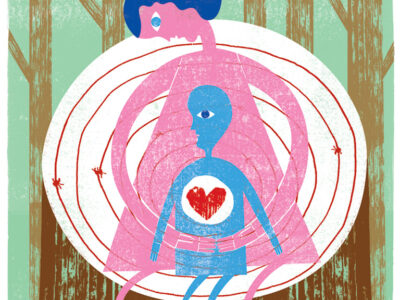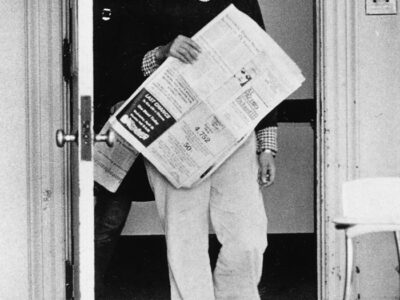
Class of ’90 | Alan Schwarz C’90 didn’t set out to be a hard-hitting investigative journalist.
He’s a math geek, after all, and has been for a long time. In kindergarten he told his teacher that he wanted to learn square roots better because he “didn’t know all of them yet.” In middle school he missed a field trip to the zoo because he was in the library, teaching himself algebra. (“I had a wonderful day,” he says. “It was much better than the Bronx Zoo.”) In high school he beat a future astrophysicist and physics professor to win a thousand-dollar math scholarship.
He had always loved sports, especially baseball, with all those batting and pitching and fielding stats to calculate, and he combined his two loves to became the statistician of the Scarsdale High School baseball team. At Penn he became a sportswriter for The Daily Pennsylvanian, writing memorable stories on college players such as the late Grover Powell W’66, a brilliant eccentric who pitched briefly for the Mets, and Steve Adkins EAS’86, who pitched even more briefly for the Yankees and Cubs.
Schwarz was, by his own admission, “a little neurotic and very high-strung,” which could be one reason why he was not voted sports editor his senior year.
“History will show that was a mistake,” says Randall Lane C’90, who was a DP editor when he and Schwarz were there and is now editor of Forbes. “He’s become one of the great sports reporters of his generation, there’s no doubt.”
Back then Schwarz didn’t have the desire to go after hard news.
“He didn’t necessarily enjoy, in those days, going for the jugular,” says Lane. “He understood the need for it, but he didn’t want to be the one who was writing negative stories.”
“I did thoughtful, smart stuff,” admits Schwarz, “but it certainly didn’t have very sharp claws.”
Schwarz had felt those claws firsthand as a 14-year-old high-school freshman, when his mother—a Harvard grad who felt limited by her career as a secretary—committed suicide. The local papers carried the news with painfully insensitive headlines that have haunted Schwarz ever since.
“I think that the callousness with which that event was covered just turned me off to what I was being told was news,” he says. And from 1982, when the death occurred, until 2007, when Schwarz joined the staff of The New York Times, he would only read (and write for) the sports pages.
Schwarz thrived as a freelancer after graduating from Penn, writing about up-and-coming players for the Times, Inside Sports, Sports Magazine, Newsweek, Baseball America, and Sports Illustrated for Kids. His first book, The Numbers Game: Baseball’s Lifelong Fascination with Statistics [“Arts,” Sept|Oct 2004], was an engagingly wonkish examination of not just the numbers but “the people obsessed with baseball’s statistics ever since the box score started it all in 1845.” He did so many interviews that he compiled his “extras” into his second book, Once Upon a Game, which recounted, among other things, Kevin Costner’s gushing love for baseball and George H.W. Bush’s meeting with Babe Ruth.
He was still a freelance baseball writer when, in early 2007, he was handed a “once-in-a-career story,” as Glenn Kramon, his editor at the Times, calls it. A former pro wrestler named Chris Nowinksi, who had been digging into the effects of football concussions, told Schwarz that Andre Waters, the Philadelphia Eagle who had just committed suicide, had suffered from a rare brain disorder. Known as chronic traumatic encephalopathy, or CTE, it is caused by repetitive trauma to the brain. Schwarz approached the Times, got the story published, and went back to reporting on the Baseball Hall of Fame. Then, a few weeks later, Patriots linebacker Ted Johnson called Schwarz and told him he was suffering from depression and memory loss after his concussions. The story was published on the eve of the Super Bowl, and Schwarz was hooked on a new beat: probing the link between head injuries and brain damage in athletes.
It is unclear whether Nowinski knew about Schwarz’s talent with numbers, but it was certainly put to use. For the next five years, Schwarz marshalled statistics to prove that retired NFL players had a heightened rate of dementia and severe brain disorders—and that college, high-school, and pee-wee players in all contact sports were also at risk. In 2010 he reported in the Times that Penn linebacker Owen Thomas W’11—who tragically killed himself in the spring of his junior year—had CTE [“Gazetteer,” Nov|Dec 2010], and that there were gross errors in the NFL’s and other experts’ research.
“He connected the dots in such a precise, linear way that it was undeniable what he had laid out,” said Randall Lane. “That is what happens when you have a sports writer who happens to be a mathematician.”
Once Schwarz started writing, “all of this stuff started happening,” says Kramon. Stuff like congressional hearings, investigations into football equipment, and more doctors on the football field. After the Times hired him as a full-time investigative reporter, his reporting was nominated for a 2011 Pulitzer Prize. In a New Yorker feature on the future of football, author Ben McGrath dedicated three out of 17 pages to Schwarz’s “work of the angels.” His old DP buddies even stopped calling him Slice, the college nickname that he detested.
But there was a downside to all that publicity.
“I just want to be left alone,” says Schwarz. And that was no longer possible.
“A lot of people thought that the NFL has gone soft since that nincompoop started writing about concussions,” says Kramon drily. This did not endear Schwarz to fans—or the NFL.
“Because this was a very intense thing, I was very much a marked man,” Schwarz says. He pauses to check his emotions. “I was worried for my safety. I was asked once, ‘Do you have a family?’
“I knew that no one was going to break my legs,” he adds quickly. “But I was in such unfamiliar territory. I just wanted to be a baseball writer—that’s all I had wanted to be … Then the next thing you know I’m not only covering but clearly driving and creating, in many respects, what people are calling the biggest sports story since the Black Sox scandal. That’s pretty heavy stuff.”
But then again, Schwarz never could shy away from a math problem, which is exactly what the concussion story was.
“I wanted [people] to understand that these numbers actually mean something,” he says. “The part of me that wanted to be a math teacher just came out.”
As the Gazette was going to press last month, the Times published Schwarz’s latest public-health story, “Risky Rise of the Good-Grade Pill,” about high-school students’ widespread abuse of Adderall, Ritalin, and other stimulants, which doctors prescribe—with alarming ease—for ADD and ADHD. The story, said Kramon weeks before its publication, had the potential to be “Concussions 2.”
Hard-hitting, indeed.
—Alyson Krueger C’07




